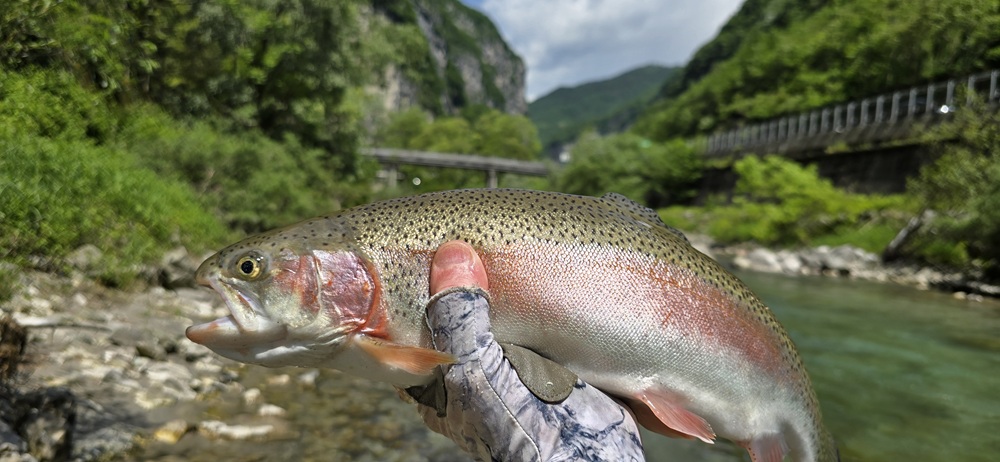
The second part of the trip worked out better trout-wise.
After my bumpy if enjoyable DIY crack at Italian flyfishing described in part one, when I got back to our base in Possagno, I reached for my laptop and seriously researched local guides.
It takes some doing to wade through the guide websites, and clearly you aren’t talking to the actual guide, and probably not even someone in the same country.
Meeting Marco
Still, I finally got in touch with a guide named Marco Naldi, who agreed to take me out for half a day, the very next day. He sent me a Maps pin for the meeting point and guess what, it was the exact same place I’d decided not to park in part one, at the electricity sub-station. Right under that CCTV camera.
The following morning, I set off on my own at first light and got there shortly before 6am. We’d agreed to meet at 6.30, but Marco drove in moments after I arrived. WhatsApp translates automatically so he’d told me he only spoke a small amount of English but this didn’t matter. My hearing is not that good anyway, and flyfishing sign language is universal.
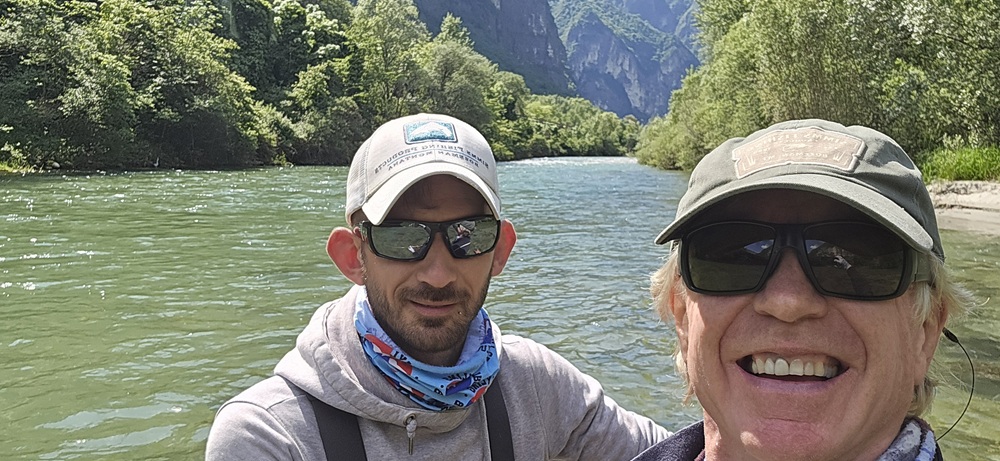
Local knowledge!
We walked the short distance to the river and I started cautiously nymphing a pool that looked like it would be stacked with fish. Forty-five minutes later and I think I’d had one touch. Marco got me to work the pool with a dry, but eventually we moved upstream, keeping with the dry through some beautiful runs. The fisheries inspector wandered down to check my licences and they were all in order and Marco got some good intelligence from him. He’d checked four groups the day before and they’d only had one fish between them all. The water was too cold from the snowmelt apparently.
When we reached the road bridge, the sun had come over the cliff. Apart from offering warmth, it dramatically improved visibility through the water. We hiked up the bank onto the road bridge I’d stood on the week before. After about ten minutes, Marco finally spotted a fish, which he said was a marble trout, and called it ‘an uncatchable fish’. Uncatchable and almost invisible, its mottled back perfectly blending in with the rock-flour coated boulders and substrate. Marco assessed the prospects, and chose the spot from where I would launch my fly. We crept down, and I waited behind a clump of rushes seven or eight metres from where the fish had been sunning itself. Half a dozen casts and no rise. Marco went back onto bridge and as he was looking, a very similar-sized fish gently cruised past me a bare rod length away. What a sight that was: a good solid three to four pound trout. Marco could no longer see the fish mid river, so we set off for our second spot.
A short distance south of Cismon, we found a wide stretch of the Brenta with good bank access into knee-to-waist-deep water. I’m not a fan of wading in algae-covered boulder-riddled rivers, but with studs (thanks Marco!) in the Orvis Ultralights, I felt glued down – at least once I stopped moving. We worked our way up a deep edge, nymphing some excellent-looking water, but still no hook ups. You can tell when a good guide is working really hard for you, and I could tell Marco was constantly thinking, ‘What next?’, and I was constantly failing to deliver on my side of the bargain.
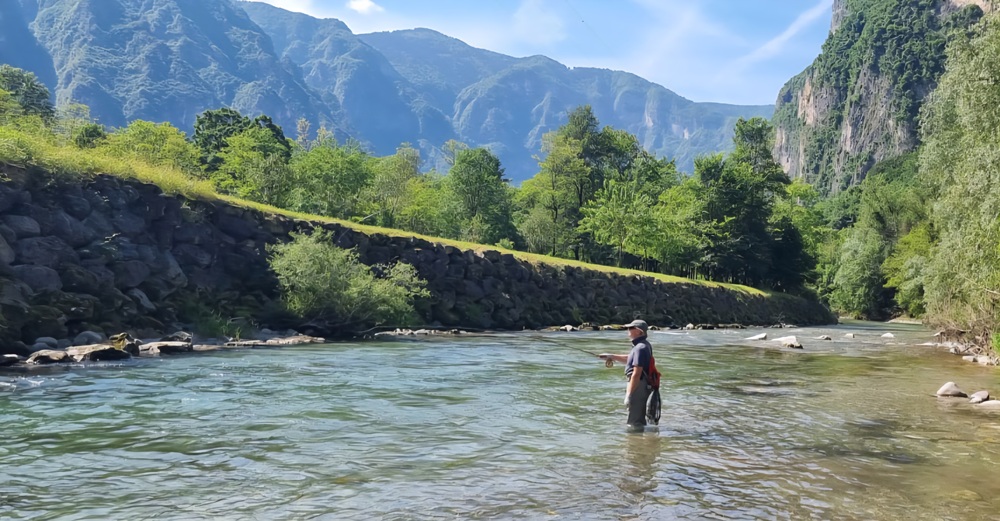
Beautiful water.
I should say that I rarely do well the first time I fish a new bit of water. Part of that I am sure is simply learning what works in a particular place and time, but a bigger part for me is the distraction of a completely new location. I just find myself looking around, wallowing in the beauty of it all, and checking out the next pool when I should be thinking of this one. I have to get past that, before I start catching. Concentration is everything when flyfishing, especially for trout.
In these circumstances, I’m not even bothered when I don’t catch fish – it’s to be expected. I was learning a lot, and very quickly, but not quickly enough.
The theme continued as we tried a third spot, and I landed my first rainbow. No giant, but hey, a fish is a fish, right? By now, I was expecting Marco to pull the pin on my half day.
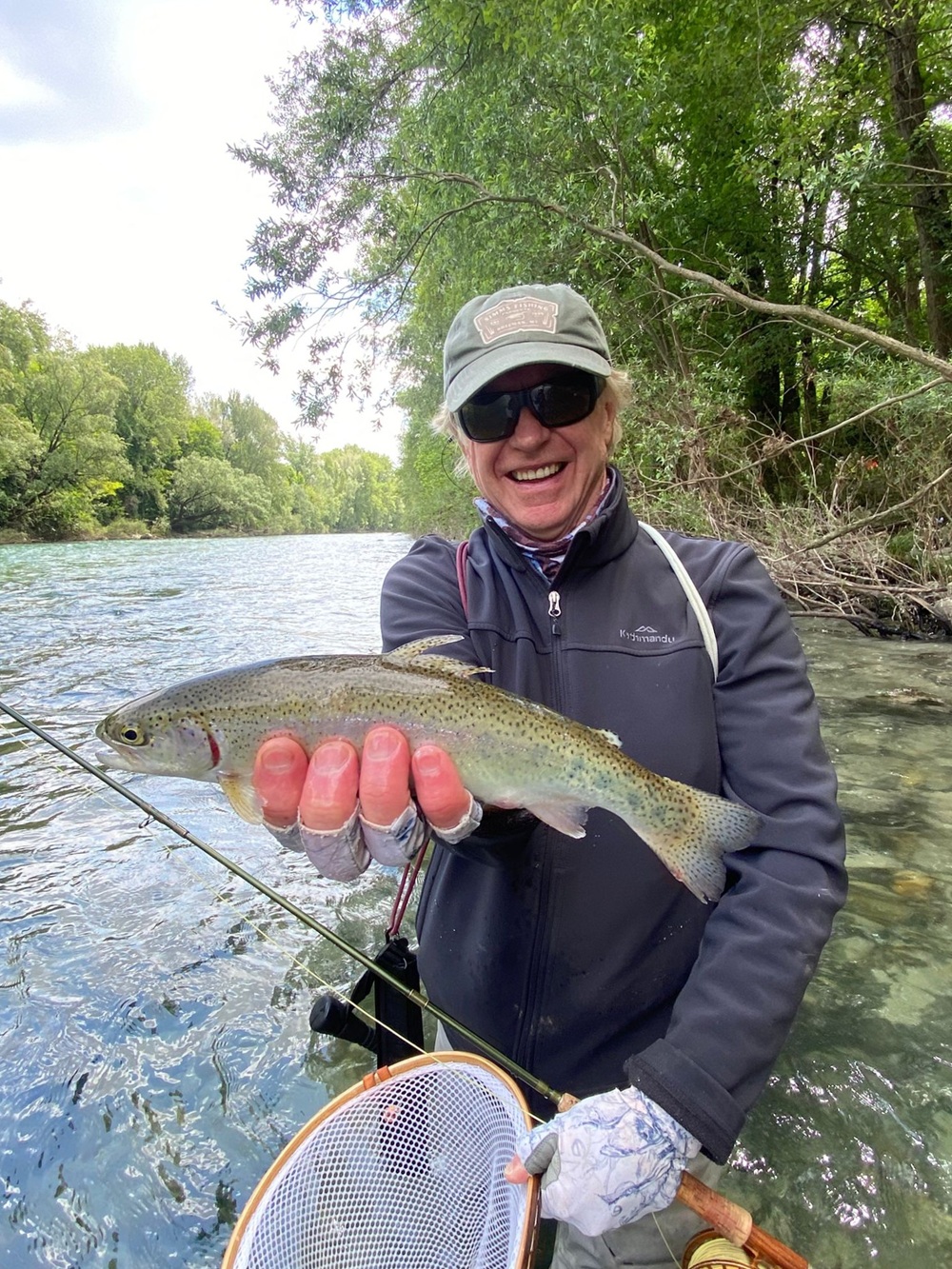
First Italian trout.
We were well past that deadline, but no, one more spot. We had to walk a kilometre or so to a high retaining wall bank with a deepwater edge. Almost immediately I nearly tripped and fell in as this monster cruised into the bank and back out again. I stuttered and pointed but Marco just shook his head and said, “Barbel”. Holy smoke, I’ve seen some barbel over the years, but this was more like a sturgeon. I watched it as it shook its head side to side to disturb the sand and pebbles, wondering what sort of fight it would give. I bet a good one, given the way it was moving and holding station in well over a metre of fast-moving water.
That got my attention and I was looking hard, but Marco, walking a short distance ahead of me, spotted a trout, sitting in front of boulder. A good brown, and it was rising in the bubble-line, swirling away from the bank and around the boulder. I threw a lot of different dries at that fish and had one eat, but no connection on a beetle, and then another enthusiastic chase on a big caddis pattern before the current destroyed the drift. Eventually, the fish disappeared upstream under a willow, and we moved on.
We soon found another trout to cast to, but it was both less interested and less patient, soon spooking into the deep water midstream. In the end it was me who called time. I swear Marco was having as much fun as I was, but we’d gone well past a full day and I felt like I was taking liberties.
Solo again
Using the invaluable knowledge I had gained from Marco, I went back to the Brenta for two further days of fishing.
I encountered a couple of very notable fish. The first was when I tried near Cismon again, saw what might well have been the same trout I’d tried for with Marco, but still couldn’t connect with it. I dropped back downriver to cast from behind the boulder. I tied on the biggest dry fly I had brought with me, a size 10 PMX which had worked so beautifully at Lake Eucumbene last December/ January. Two casts later, the trout consumed it.
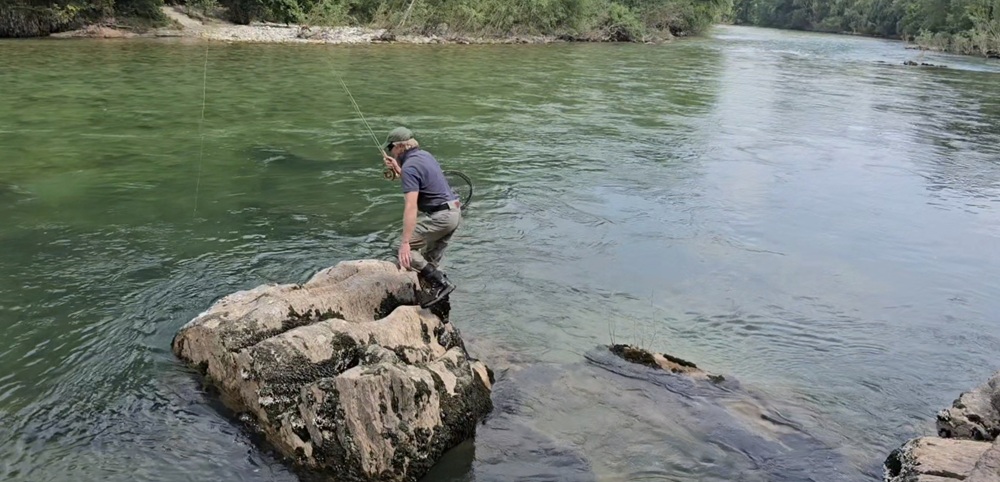
Hooked up on the Brenta.
Like a lot of good fish, it took a bit of time to realise it was hooked, but when it did, it took off around the boulder and into an undercut or cave I had no idea was there. The line stopped pulling and I thought it had done me. But I dropped off the wall, waded onto a rock platform and up the boulder, gently pushing the rod out. To my amazement, out popped the still hooked fish, before it tore off downstream in the current. If it hadn’t then drifted in towards the bank I would not have landed it – there was just no way to chase it down the river. But with luck on my side, in another few minutes I had this amazingly colourful brown in the net.
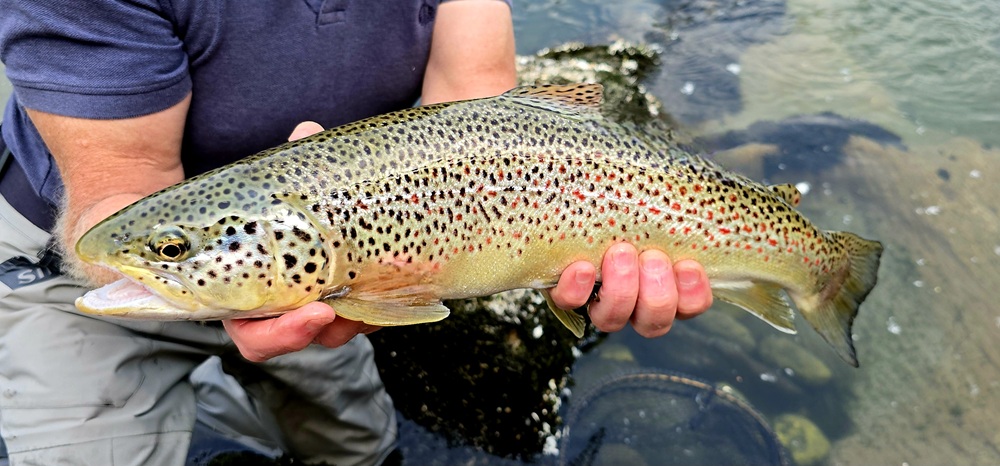
Landed at last.
Buoyed by this success, I messaged Marco with a video of the whole effort, and, stretching the new friendship, asked him for a Maps pin for a potential location further upstream so I could do a bit of exploring. He sent me one, and a few days later I headed there, checking out a few spots enroute.
The scenery was spectacular. All but the most vertical cliffs are tree-covered here and the greenness is overwhelming – even by UK standards. The water had become very clear as the snowmelt reduced. This clarity was despite what seemed to me to be high levels of urban development near the river, much of it hundreds of years old, merging with more recent industrial activity and a major highway.
But once on the water, you could be a million miles from anywhere. The vegetation and landscape absorb the road noise, and the sound of the river takes over. The water temperature was around 14 degrees and there was plenty of visible insect life. Beetles, willow grubs, stoneflies as long as a finger, and of course caddis. If humans ever left this space, nature would quickly take over.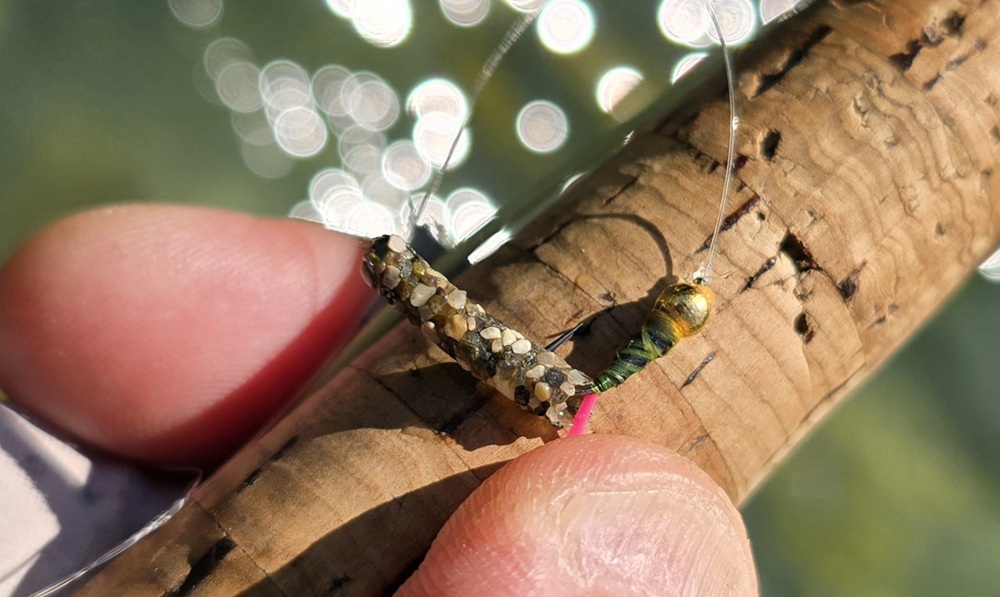
Cased caddis.
When I got to Marco’s spot it was immediately obvious why he’d suggested it. Nice easy access! Not too adventurous, and helped by the fact the flows this far up the river were much more manageable. I walked down and fished back up through some amazing water before finally tracking down several fish, all rainbows. Despite my efforts to get another fish on a nymph on what was very nymphy water, they were looking up. And the bigger the lump of fluff and fur, the better.
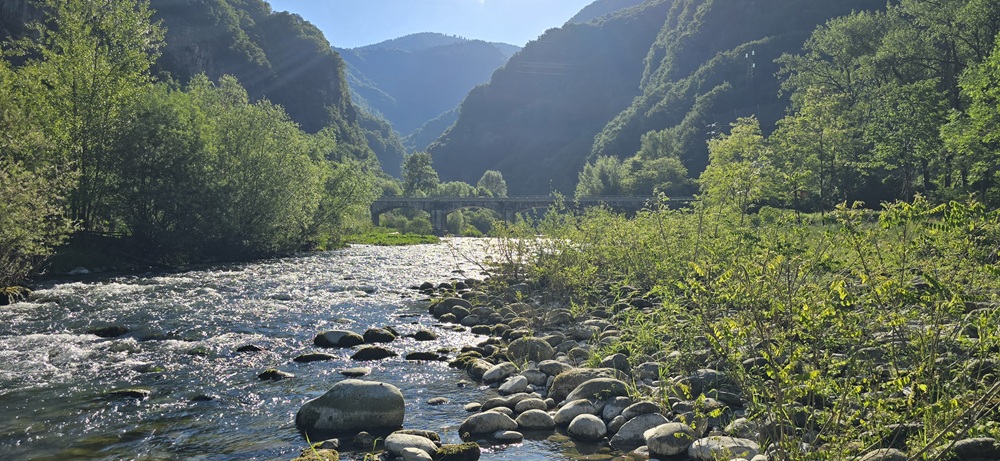
More beautiful water.
To go back in time for a moment, I was fishing the Murrumbidgee above Adaminaby one day with the Editor. We'd had a good haul of standard ¾ pounders, when I watched Philip land a solid 3lb plus brown he rose from a pocket hard against the bank, fed by a channel of water swirling around a small rock.
I would not have thought to fish it, but having seen Phil pull out the fish of the day, I've been a convert ever since to popping the fly, wet or dry, into any little pocket that could be home to a good trout.
So it was that, back in Italy, the best rainbow of the day came from a pocket no bigger than my laptop screen, and hard against the left bank. The fly landed, and my large Elk Hair Caddis sat there nicely for several seconds before the trout's snout emerged, and the fly disappeared. I lifted into a solid weight, which moments later left its secret lair and careered into the main river, heading south for Venice. It got as far as the nearest deep pool, but I managed to stumble through the boulders (thankfully in quite shallow water) to stay in touch. After a strong scrap, the rainbow came to the net.
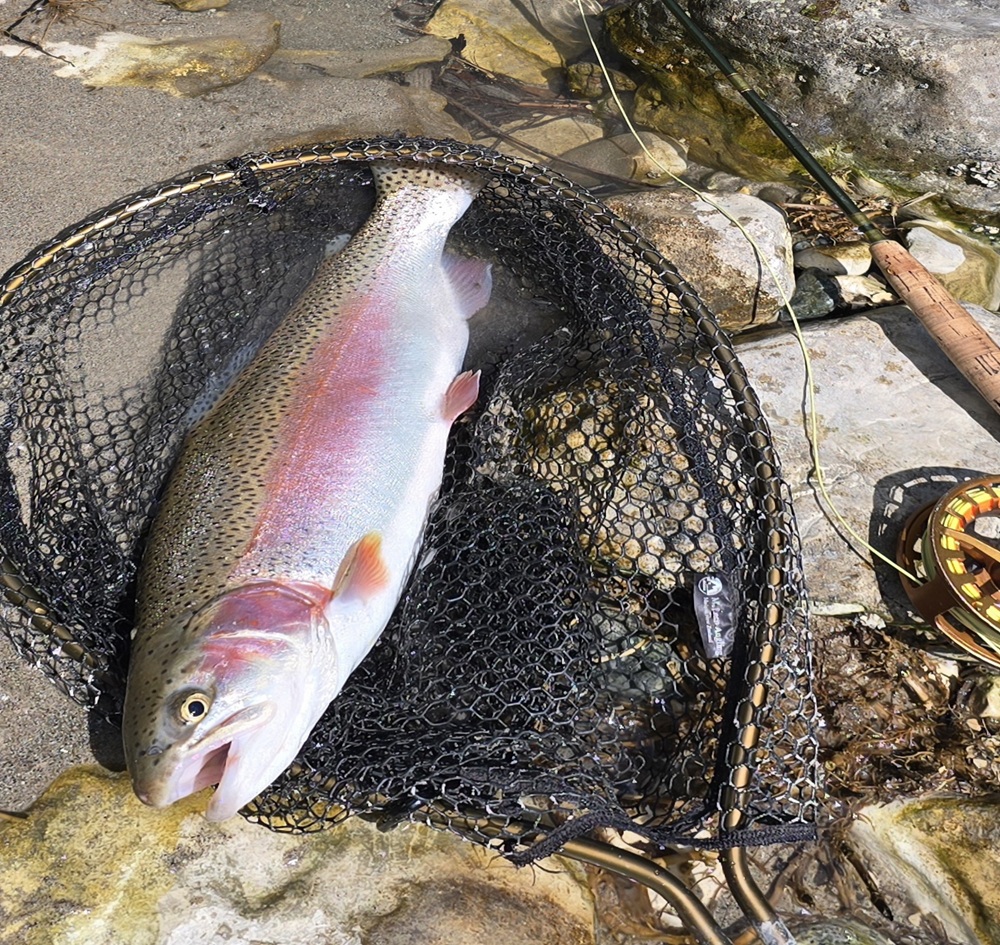
Solid rainbow on an Elk Hair Caddis.
The further I got from the easy access points, the more fish I saw. I’d walked a fair distance past the carpark, and thought I’d call it a day when I got to the road bridge. I was watching the pool near a bridge pylon, trying to work out whether what I could see was a fish, or a boulder, or clump of weed, when a second ‘boulder’ drifted into view.
I threw everything at those trout for over an hour. I could see them lifting into the current to feed, and interacting aggressively with smaller fish raiding their spot, but nothing I could do got their attention.
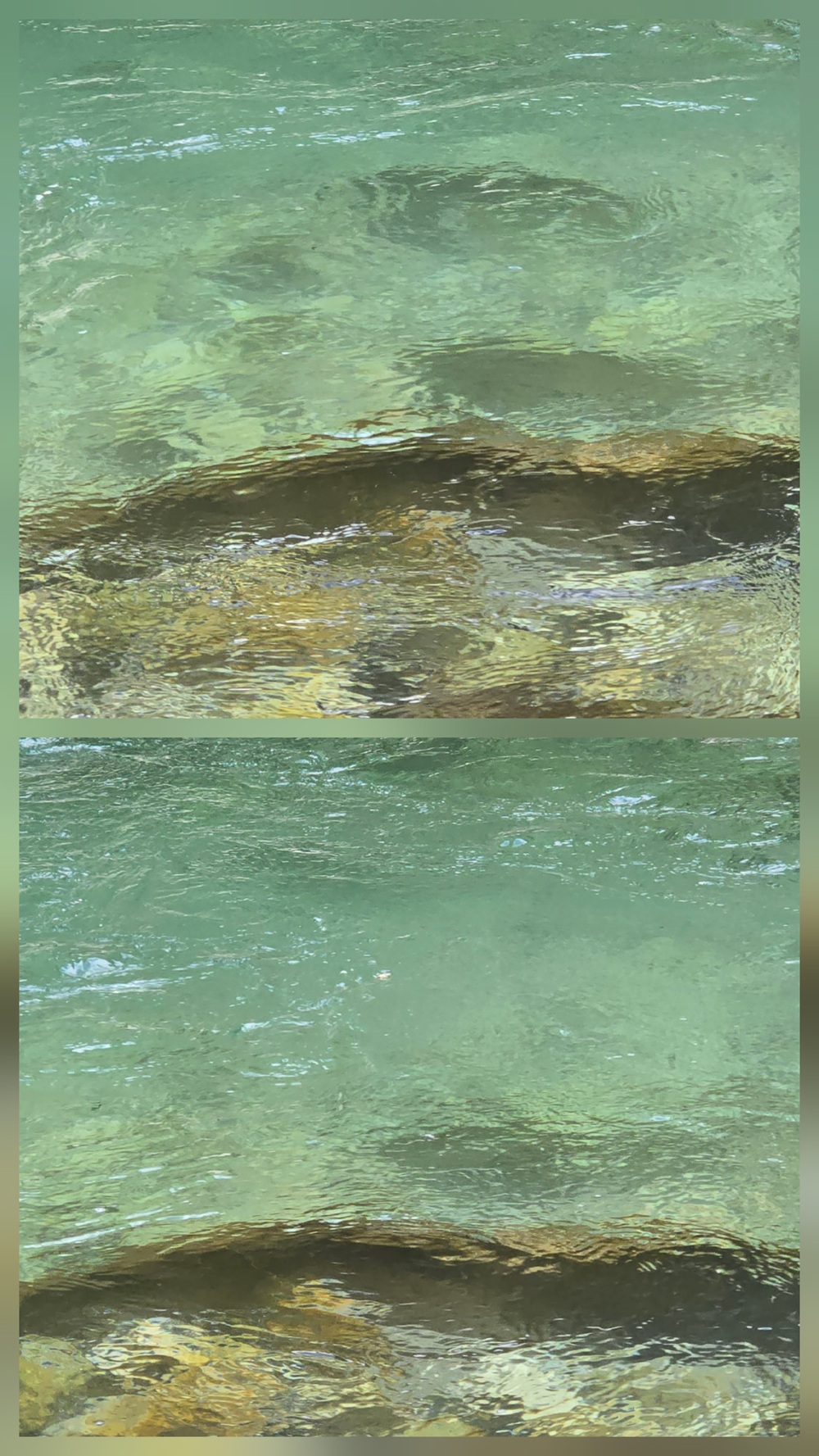
When one 'boulder' became two, I realised I was in fact watching very big trout.
There was an undercut in front of another very large boulder with a current running under it; strong enough to drag three of my nymph rigs in, all of which I lost.
After the third loss, I philosophically drew a line under this trip, realising I really didn’t need to catch any more fish. Kat, who I’d last seen swimming in a pool downstream taking leave from her photographer duties (which I gratefully acknowledge), had tracked me down and had been scrutinising my efforts from the bridge. So I hiked back downriver to a point where I could exit without a harness and rappelling gear. Before I was back at the car, I had mentally started to pack my rods, and to look forward to a bit of Cornish reservoir fishing on gently sloping hillsides.
Marble trout
If there's one thing I would definitely go back for, it would be to catch a marble trout, Salmo marmoratus. Native only to rivers flowing into the Adriatic Sea, this species has a unique marbled colouration, and the largest caught on record was nearly 50 pounds! Despite a fraught conservation history, thankfully, these days they’re not rare, and live alongside the native browns and introduced rainbows. I just didn’t catch one. Apparently, they are more common the further up into the mountains you go. I asked Marco for a picture, which he again graciously provided.
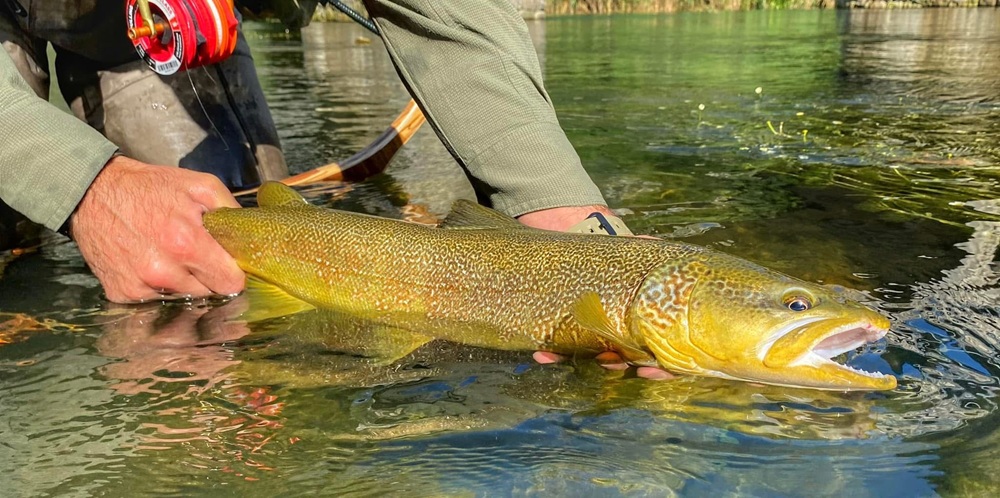
I'll need to go back for one of these! (Marco Naldi pic.)
FLYSTREAM FACTS: Observations and tips on travelling in northern Italy
Not speaking Italian is not really a barrier. Many Italians speak English, and there are so many similar words that you can get by, especially with Google Lens to read menus and signs. Driving on the right hand side of the road is okay (just remember to keep your head in the middle of the road). Italians aren’t patient drivers, but they also aren’t rude. I saw no road rage, and heard hardly any tooting. They just drive ridiculously fast, completely ignore speed limits, and overtake on blind bends. They aren’t courteous, don’t let you merge, and don’t give way. However, I saw no evidence of the kind of road carnage driving like this might be expected to cause, so I take from this that they’re generally good drivers. (Road death rates per 100,000 population are, for the UK 2.6, Australia 4.5, and Italy 5.3.) Maps got me everywhere I needed to go and didn’t miss a beat.
Oh, and I’ve figured out why everyone drinks espresso and macchiato here. As far as I can tell there are no public toilets, so you can’t drink the volume of fluids we’re used to. Toilets are in the cafes and bars. I felt like it was a 5 Euro toilet charge with a free coffee!
There are plenty of tackle shops, but I didn’t find one with flyfishing equipment. Bring a typical range of dries and nymphs; the one fly I didn’t have which appears quite popular is a large cranefly imitation. I only saw one other group of flyfishers, four blokes, all fishing together. Three watching one, and they were friendly. They said that’s how they fished, with only one or two fishing at any one time. (The others presumably recovering their mate’s flies from the willows!) When I spoke to them, they hadn’t caught anything, which made me feel quite smug.
I used Air BnB for a few nights when we travelled around. I got an apartment or hotel for 50 to 60 Euros a night, even close to Venice, without any problem. Train travel is cheap. Beautiful and fast trains, immaculately maintained. Even during a one day general strike, there were still enough trains to get us in and out of Venice without any real problem. The food was amazing of course and I made a point of eating pasta or pizza almost every day. I shopped in a local village store. Great fresh veg, salad, and fruit; wine was sold from self-serve taps into reusable bottles for less 2 Euros a litre; the cheese and cold meats counters were beyond description; and great breads too, although generally a narrower range than we’re used to: mostly just white, and occasionally wholemeal. You cannot diet in Italy!
Finally, to state the bleeding obvious, I would gladly recommend Marco if you fancied a bit of guided flyfishing in the area: Appennino Fly Fishing Marco Naldi











